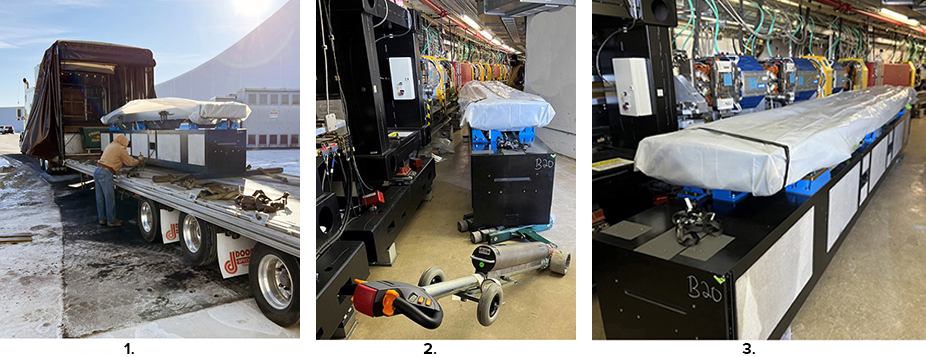
The new storage ring built for the Advanced Photon Source (APS) Upgrade Project at the U.S. Department of Energy’s Argonne National Laboratory will be made up of 1,321 precisely aligned magnets. They, and all associated electrical, water, and vacuum systems will be assembled into three types of a total of 200 modules, all mounted to concrete platforms called plinths, and then transported from the assembly area to the APS storage ring. It takes specialized equipment to make the move safely and efficiently.
An APS Upgrade team successfully moved one of the larger plinths – nearly 20 feet long and weighing roughly 30,000 pounds before the heavy magnets (which add another 10,000 pounds) are assembled atop it – in order to test that equipment, and make sure it could maneuver the plinth through doorways and into the storage ring area.
They transported the plinth to the APS by truck (photo 1) and moved it using a PowerAttack device (photo 2), an alternative to traditional forklift technology, to maneuver a plinth through doorways and into the storage ring at the heart of the APS.
The plinths will be moved, one by one, into the APS storage ring facility during the one-year shutdown for the APS Upgrade. This test run helped the APS-U team determine how to maneuver the completed modules into the ring (photo 3).
“It all worked out very well,” said Ralph Bechtold, principal mechanical engineering specialist with the APS Upgrade. (All photos by Ralph Bechtold, Argonne National Laboratory)
The Advanced Photon Source is a DOE Office of Science User Facility operated for the DOE Office of Science by Argonne National Laboratory under Contract No. DE-AC02-06CH11357
The U.S. Department of Energy's APS at Argonne National Laboratory is one of the world’s most productive x-ray light source facilities. Each year, the APS provides high-brightness x-ray beams to a diverse community of more than 5,000 researchers in materials science, chemistry, condensed matter physics, the life and environmental sciences, and applied research. Researchers using the APS produce over 2,000 publications each year detailing impactful discoveries, and solve more vital biological protein structures than users of any other x-ray light source research facility. APS x-rays are ideally suited for explorations of materials and biological structures; elemental distribution; chemical, magnetic, electronic states; and a wide range of technologically important engineering systems from batteries to fuel injector sprays, all of which are the foundations of our nation’s economic, technological, and physical well-being.
Argonne National Laboratory seeks solutions to pressing national problems in science and technology. The nation's first national laboratory, Argonne conducts leading-edge basic and applied scientific research in virtually every scientific discipline. Argonne researchers work closely with researchers from hundreds of companies, universities, and federal, state and municipal agencies to help them solve their specific problems, advance America's scientific leadership and prepare the nation for a better future. With employees from more than 60 nations, Argonne is managed by UChicago Argonne, LLC, for the U.S. DOE Office of Science.
The U.S. Department of Energy's Office of Science is the single largest supporter of basic research in the physical sciences in the United States and is working to address some of the most pressing challenges of our time. For more information, visit the Office of Science website.
